At the Gates of Loyang
 At the Gates of Loyang:
original rules of Hall Games
At the Gates of Loyang:
original rules of Hall Games
Introduction
China, 2000 years ago: Loyang (Luòyáng / 洛阳) has risen to become the Capital of the Han Dynasty and one of the four great Capitals of
old China. The economic upturn of the now-flourishing city requires a better supply of basic foodstuffs. These are provided by the local farmers,
who plant wheat, pumpkins, turnips, cabbages, beans and leeks in their fields.
After each harvest, the farmers assemble at the gates of Loyang to sell and trade their vegetables. They deliver to their regular customers or
lucratively sell their vegetables to passing shoppers. Vegetables can also be traded at Market stalls or used for seed and planted in fields.
If the farmers need vegetables that they don’t have in stock, they can buy them in the Shop. Twenty different helpers, each with different
individual skills, are available to assist them.
The most successful farmer will be the one who moves furthest along the Path of Prosperity within the given timeframe.
Each step costs more and more money, which is also needed for investments. Farmers have to find the right balance.
The coins have square holes, so that they can be held on strings. They have the Chinese name “Cash”,
from which the modern term derives.
Game components
on counter sheets:
- 4 T-shaped game boards (with Path of Prosperity and Shop)

- 12 Satisfaction markers (blue/red)


- 24 1-Cash coins (small)
- 14 5-Cash coins (large)
237 wooden tokens:

|
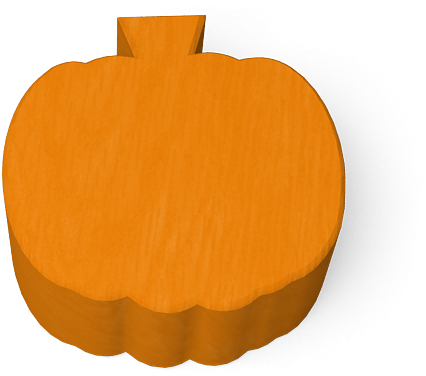
|
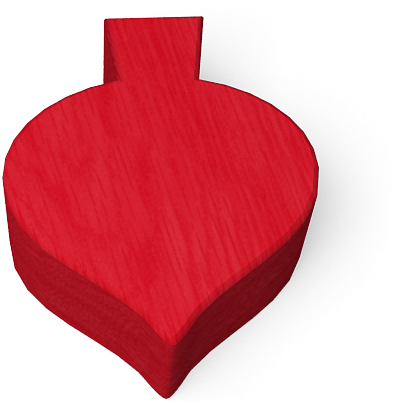
|
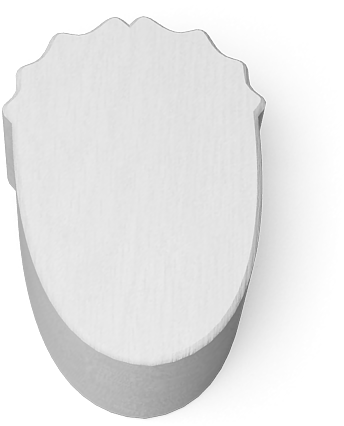
|
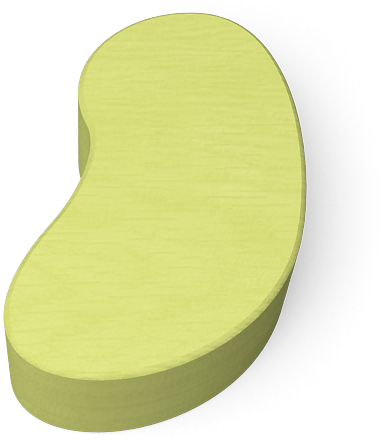
|
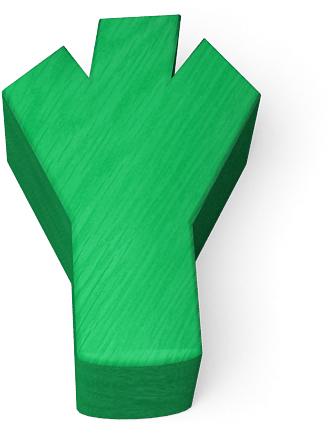
|
|
48 wheat
|
46 pumpkins
|
44 turnips
|
36 cabbages
|
32 beans
|
25 leeks
|
- 4 Scoring markers (to show progress on the Path of Prosperity)
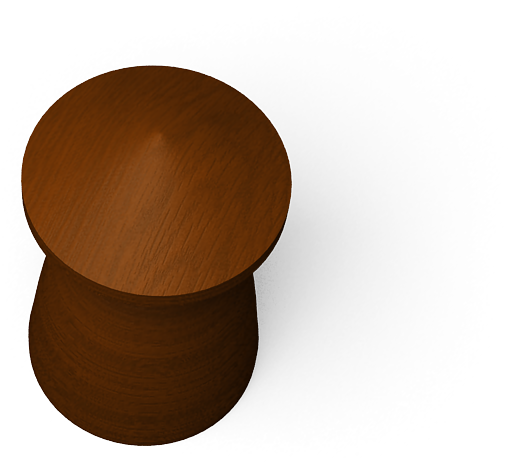
- 2 Starting player tokens (1 larger, 1 smaller)

120 Cards:
- 4 “Storehouse / Cart” cards
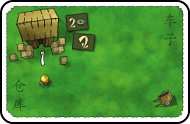
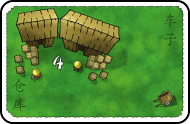
- 4 “Turn Summary” cards
- 6 “Loan” cards
- 36 Private fields (green backs):
- 4 Home field cards (9 spaces)




- 8 fields with 3 spaces each








- 8 fields with 4 spaces each








- 8 fields with 5 spaces each








- 8 fields with 6 spaces each








-
70 action cards (brown backs):
- 6 common fields (2 each with 3/4/5 spaces)
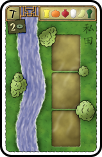
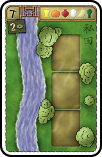
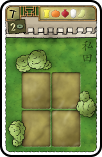
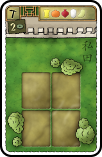
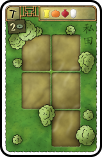
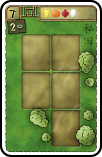
- 14 Market stalls (orange)
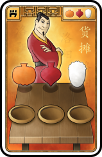
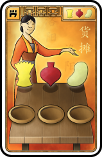
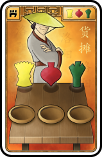
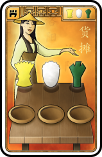
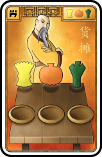
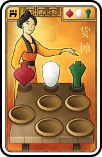
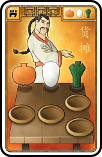
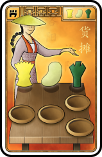
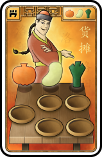
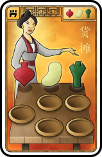
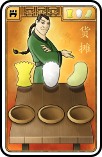
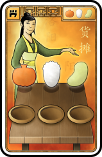
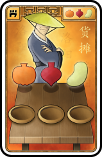
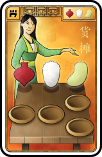
- 14 Regular customers (blue)
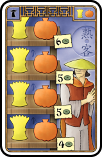
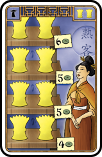
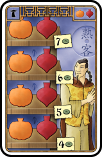
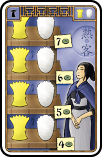
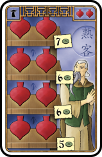
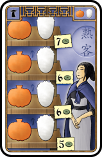
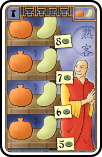
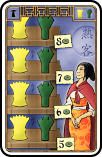
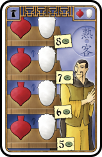
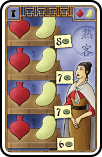
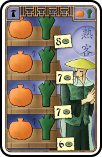
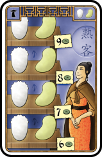
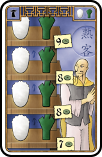
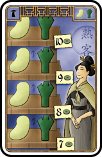
- 14 Casual customers (red)
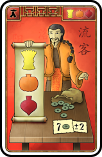
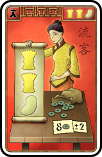
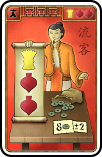
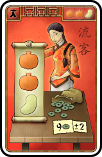
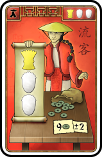
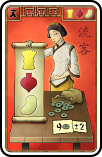
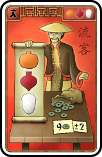
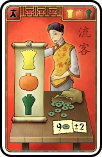
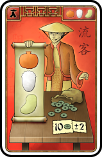
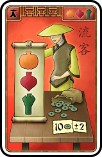
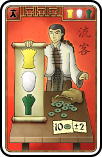
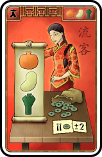
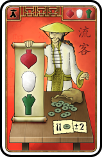
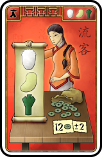
- 22 Helpers (beige)
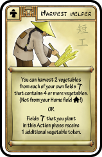
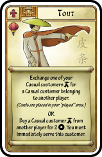
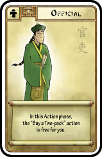
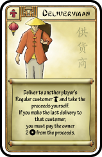
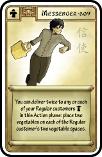
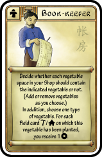
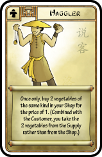
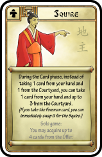
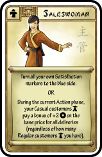
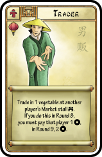
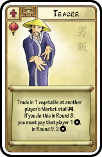
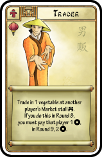
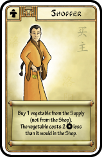
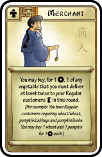
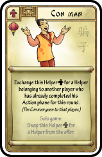
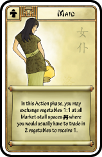
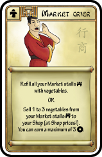
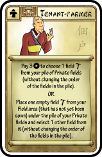
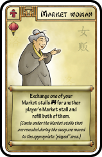
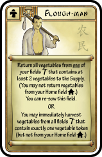
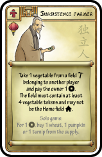
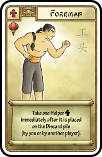
The helper card Foreman is not available for Yucata, as it is not suited to asynchronous play.
Important note for handling the game: to look at the actions another player has taken, you can move the mouse
over the foot symbol. Then a window will be displayed which allows you to choose a turn which you want to see. A click
on the button “Next action” will perform the next action. A click on the button “replay off”
will finish this last move display, and you will see the current turn again.
Game Setup
Separate the money, the vegetables, the Satisfaction markers and the Loan cards and
place them on the table as the Supply.
There should be an adequate supply of all components.
Should there, unexpectedly, not be enough, players should improvise additional tokens.
Shuffle the Action cards and place them in a face-down pile.
Each player receives the following items:
- 1 T-shaped game board
- 10 Cash
- 1 Home field
- 1 Scoring token (place it at
the bottom of the Path of Prosperity)
- 1 “Storehouse / Cart” card
- 1 “Turn Summary” card
- Vegetables to stock the Shop:
3 wheat, 2 pumpkins, 2 turnips,
2 cabbages, 1 bean and 1 leek.
(The two pale-coloured spaces in the Shop remain empty.
As a general rule: dark price tags show the cost that must be
paid to buy the vegetable; pale price tags show the price a
player can receive for selling it to the Shop.)
- 8 Private fields (with green backs):
2 sets, each of 4 cards with 3, 4, 5 and 6 spaces.
Shuffle each set of 4 cards then place one set on
top of the other, face-down and to the left of the
Home field. This forms the Field pile.
Choose a Starting player, who takes the larger Starting player token.
(The smaller Starting player token is not used at the start of the game.)
Special rules for the Introductory version:
Shuffle the 4 Regular customers that are marked with a blue dot in the space for the Satisfaction marker. Deal one,
face-down, to each player. Players look at the cards and can hold them in their hand until they decide to play them
during a Card phase. In a 2- or 3-player game, any remaining Regular customers are returned to the Action card deck.
Each player is dealt 4 action cards at the beginning. These will be the cards that he
has available in the first card phase.
Beginning with the Starting player and continuing in clockwise order,
each player buys 1 vegetable from his own shop and plants it in his Home field.
(Price: see the dark price tags between the vegetables in the Shop.)
“To plant” means to place the vegetable on a Field card. All other spaces on that
field are then filled with the same vegetable. The additional tokens are taken from the Supply.
There are two restrictions here:
- Only the vegetables that are shown on the Home field card can be
bought and planted (that is, only wheat, pumpkins or turnips)
- No more than 2 players may plant the same type of vegetable
at the start of the game.
Playing the game
The game is played over 9 Rounds. Each Round consists of 3 Phases:
- Harvest phase (players receive one new field and harvest vegetables from their fields)
- Card phase (players each play 2 Action cards, then a new Starting player is chosen)
- Action phase (players buy and sell vegetables, then progress on the Path of Prosperity).
During the Card phase, players receive new cards. They use these in the Action phase
to convert the harvested vegetables to money.
Players can take out loans at any time during the game.
At any time during the game, players can see how many rounds are left by counting the
remaining vegetables on their Home field.
Phase 1: Harvest phase
All players carry out the Harvest phase simultaneously.
- Each player turns over the top field from his Field pile and places it to the right
of his other fields. In the last round, there is no new field to uncover.
- Each player harvests exactly 1 vegetable from each of his fields. He places the harvested
vegetable(s) and any vegetables that were left in his Storehouse from previous turns on (or beside)
his Cart. (Unlike the Storehouse, there is no limit on how many vegetables a Cart can hold.)
- Once the last vegetable has been removed from a Private field, it is removed from the
game. In contrast, fully harvested Common fields from the Action card deck are placed on the Action
card discard pile (“The Discard pile”). (Common fields from the Action card deck can be recognised by
the Cost symbol at the top left). Fields that have not yet been sown are not discarded.
This phase will be executed automatically at Yucata. If you have
the helper card “Harvest Helper” available, you will get a turn in this phase
and can choose if you want to play that helper. Note that there will already be one
vegetable harvested from each field, so when playing the Harvest Helper you can choose
to harvest another vegetable from fields with at least 3 vegetables on them.
Phase 2: Card phase
- At the start of the Card phase (and only then), create a new Draw pile by shuffling
the Discard pile into the remaining Draw pile.
- Deal each player a hand of 4 Action cards.
- Next comes the Distribution round. Each player will play 2 Action cards face-up
into his own playing area.
At Yucata, all cards are usually displayed in a window
which covers the fields and some part of the card display. This window can be minimized by clicking on the button
in the upper left corner. Moreover the cards are displayed below the game board if your browser window is large enough.
Note: A card, once played, cannot be discarded until it has been used.
Helper cards ONLY can be discarded at any time.
Distribution round
During the Distribution round, each player plays exactly 1 card from his hand and
exactly 1 card from the common “Courtyard”:
-
The player with the larger Starting player token places one card from his hand
face up in the centre of the table, opening the “Courtyard”.
Players then take turns in clockwise order. On his turn, a player must choose one of the
following two options. Passing is never allowed.
- The player places 1 card from his hand into the Courtyard; or
- The player takes exactly 1 card from the Courtyard and exactly 1 card from his hand.
He plays both cards by placing them face-up in the appropriate part of his own play area.
Any remaining cards from his hand are placed face-up in the Courtyard, and the player
takes no further part in the Distribution round.
Note: The last player left to choose in a given round may no longer place any cards
into the Courtyard, but must immediately choose from the available cards.
Special rules for the Introductory version
When playing the two cards, a player may play the Regular customer that was dealt to him at the
start of the game instead of a card from his hand. There is no restriction on the number of
rounds for which a player may hold this Regular customer. (As well as this Regular customer, the
player also chooses a card from the Courtyard. He may not play a card from his hand. Once he
has played, all the remaining cards in his hand are placed in the Courtyard.)
Special rules for 2 players:
During the Distribution round, at the start of his turn, a player may choose to turn over the top Action card
from the Draw pile and place it in the Courtyard. (This is also allowed when only one player is left and he
must immediately choose from the available cards. This special rule gives players a wider choice of cards. The
rule also allows the Starting player to immediately make a selection, even before his opponent has had a turn.)
Important:
- Whenever a Regular customer is played, immediately place a Satisfaction marker (with its blue side up)
on the marked area on the right hand side of the card.
- Whenever a Market stall is played, immediately fill it with the vegetables shown.
- Whenever a player plays a “Field” Action card, he must immediately pay 2 Cash for it. To make the
payment, the player may (even out of turn) sell vegetables to his Shop, use Helpers, or take out a Loan.
(Private fields are free, but there is a charge for Common fields).
Notes and Special Cases:
- A player may never choose to play 2 cards from the Courtyard or 2 cards from
his hand; he must always play 1 card from the Courtyard and 1 from his hand.
- If the active player has only 1 card remaining in his hand, he must immediately
play it and choose 1 card from the Courtyard. A player’s last card may never
be placed in the Courtyard; it must be played from his hand.
- If a player only has one field left in hand, which costs 2 cash, he has to raise
the money for this, even if it means that he has to take a loan.
- There is no limit to the number of cards that may be placed in any row
of a player’s play area.
At the end of the Distribution round, the remaining cards in the Courtyard form a new face-up
Discard pile. They will be shuffled into the Draw pile at the start of the next Card phase.
End of the card phase
Choose a new starting player
The last player to play two Action cards during the Card phase receives the large Starting player token
and becomes the Starting player. The second last player to play two cards receives the smaller Starting player
token and becomes the Second player.
At Yucata, there is a starting player token displayed beneath each player name with a number on it.
This number gives the position of the player in the turn order of the current phase.
Phase 3: Action phase
A player may take actions in any order during his turn.
The Turn Summary card gives an overview of all actions.
A player may take any action, with the exception of Action H, “Buy a Two-pack”,
as many times as he wishes during a round.
A player who takes an action more than once may also take other actions in between.
At the end of their turns, players must store their vegetables and may move their Scoring marker.
The Starting player begins, then the Second player.
In a three-player game, the player with no Starting player token is third to play.
Special rules for the Four-player game
In each round, the Starting player chooses one of the two non-Starting players as his partner for the Action
phase. The other non-Starting player is paired with the Second player. The Starting and Second players take
their Action phase at the same time. Once they have finished, their partners can have their turns.
Note: Whenever a player takes an action that refers explicitly to “the other players”, only the player’s current
partner may be affected. Cards which allow this type of action can be recognised by a Chinese lantern symbol.
At Yucata, the players in a four-player game will play the action phase successively
in the following order: starting player, second starting player, partner of the first starting player, partner of
the second starting player. The restriction still holds that interactive action cards can only be played against the player's current
partner. You can recognize your partner in two ways: his starting player marker is highlighted in the same way as your starting player marker,
and the player with number 1 plays with the player with number 3, and the player with number 2 plays with the player with number 4.
The individual actions
A - Sow Vegetables as Seed
The player takes 1 vegetable from his Cart and places it on an empty field.
The remaining spaces on the field are filled with vegetables of the same type, which are taken from the Supply.
The top border of each field shows which vegetables can be planted on it. The more spaces on a field, the fewer
types of vegetable can be planted.
At Yucata, you have to click on the button “Plant vegetable”. Then
click on the vegetable on your cart that you want to use as seed, and then click on the field
on which this vegetable should be planted.
B - Buy Vegetables in the Shop
The player buys 1 vegetable from his own Shop and places it in his Cart.
A player can only buy vegetables that are available in his Shop.
The purchase price is shown in the Shop, on the darker price tag beside the vegetable.
At Yucata, you have to click on the button “Buy vegetable”.
Then all vegetables will be highlighted that you could currently buy without playing a helper.
You can choose to play a helper which improves your ability to buy vegetables, or you directly
click on the vegetable that you want to buy. There is no check in advance if you really can buy
a vegetable, because this depends on the helpers you decide to play.
C - Sell Vegetables to the Shop
The player takes 1 vegetable from his Cart and sells it to his own Shop.
Each place in the Shop is reserved for a specific type of vegetable. A player can only sell vegetables if he has
appropriate free space(s) in his Shop. The selling price is shown in the Shop: use the lighter-coloured price tag.
(Players receive 1 Cash for selling Wheat, Pumpkins, Turnips and Cabbages, and 2 Cash for selling Beans
and Leeks.)
Note: This action can be taken at any time during the game. This includes during the Card phase or
during Action H (Buy a Two-pack), in order to finance purchase of a new Field.
At Yucata, you have to click on the button “Sell vegetable”.
Then all vegetables that can be sold to the shop are highlighted. When you click on a highlighted
vegetable it will be sold to the shop.
D - Trade Vegetables at a Market stall
The player trades 1 or 2 vegetables of his choice from his Cart for 1 vegetable
from a Market stall.
The number of bowls on the Market stall shows how many vegetables must be traded for the one that is on
offer. These are returned to the Supply. The player then moves the vegetable from the Market stall to his Cart.
If a Market stall is empty after an exchange, it is immediately placed on the Discard pile.
Notes and special cases:
- When a player plays or reveals (see Action H) a Market stall, immediately fill it (from the Supply)
with the vegetables shown on the card. Fill the Market stall immediately, even if another player
has caused it to be revealed.
- Players may trade in a vegetable for the same type of vegetable (e.g. Wheat for Wheat).
- A vegetable which has been acquired from a Market stall may immediately be traded for another.
- Once a Market stall has been played, it cannot be discarded until it has been completely emptied.
At Yucata, you have to click on the button “Trade vegetable”.
Then you can choose a vegetable from one of your market stalls that you want to get.
Before getting the vegetable, you have to click on one or two vegetables on your Cart which will
be given in exchange for the previously selected vegetable. After you have given away the
necessary number of vegetables, you will get the vegetable that you selected.
E - Play or discard a Helper
A player can use a Helper’s skills or discard the Helper without using it.
Most Helpers are played during the Action phase, but some can also be played in other phases of the
game: the phase is indicated in the text on the cards. (see the Helper Reference sheet on pages 10 and 11).
As soon as a Helper is used, place it on the Discard pile. Helper cards are the only kind of card
that can be discarded at any time without being used.
Notes and Special cases:
- There are 20 different Helpers. Each Helper appears on one card,
with the exception of the Trader, who appears on three.
- Some Helpers (marked with a purple lantern) refer to “other players”.
These allow players to affect other players’ playing areas.
- If a player removes the top card of another player’s Two-pack, the lower card is immediately
moved to the appropriate place. (Neither player can stop the lower card from being revealed.)
Remember: In a 4-player game, all Actions that refer to “another player” only refer
to the active player’s partner for that Action phase.
- Some Helper cards offer a choice of two Actions (“or”).
A player can only ever use one of the two options when using that Helper.
- There are no Helpers that can affect another player’s Home field, Cart or Storehouse.
Vegetables in these areas are always safe from other players’ actions.
At Yucata, you have to click on the button “Play helper”
if you want to play a helper, and on the button “Discard helper” if you want to discard
a helper. Then you can click on the helper that you want to play or discard. Depending on the
kind of helper there may now be several options from which you can choose. Some helpers
can be clicked directly during another action (for example the Book-keeper and the Market Crier
during the action “Buy Two-pack”.
F - Deliver to a Regular Customer
A player can deliver vegetables to his Regular customers in any order.
Each Regular customer card contains eight empty spaces; the two vegetables shown will be delivered here for
four rounds. Regular customers want to receive these two vegetables exactly once in each round, starting with
the round in which the card was played. When a player plays a Regular customer, place a Satisfaction marker
with the blue side facing up on the marker space at the top right of the card. If a player cannot or does not wish
to deliver to a Regular customer in a particular Round, he turns the Satisfaction marker to the red side.
If the player does not deliver to a Regular customer when the red side is already facing up, he must pay a
penalty of 2 Cash to the Supply.
Notes and Special cases:
- Fill the Regular customer card from the bottom to the top.
The arrows between the prices are a reminder of this.
- When a player makes a delivery to a Regular customer,
he receives the payment for the delivery immediately.
- Players may not partially fill a row (that is, only supply 1 vegetable).
- A Regular customer’s first delivery is due in the Round when it is played.
- If a player’s Regular customer is revealed during another player’s action (see Action H),
it only requires delivery in that round if the player has not taken his turn yet.
- To raise money to pay the penalty of 2 Cash, a player can sell vegetables from
his Cart to the empty spaces in his Shop, place Helpers or take out a Loan.
- Immediately after the fourth (top) line of a Regular customer is filled,
the card must be emptied and discarded.
- Once a Regular customer card has been played, it cannot be discarded
until the Regular customer has received 4 Deliveries.
Detailed example: Nina places the Regular customer who pays 5/6/7/8 Cash for Turnips and Cabbages in
front of herself. She places a blue Satisfaction marker on the card. During this Action phase, she must deliver to
the Regular customer: she delivers 1 turnip and 1 cabbage as required and receives 5 Cash. In the next round,
she does not deliver the two vegetables, and she turns the Satisfaction marker to the red side. In the following
round, she delivers again and receives 6 Cash. The Satisfaction marker stays red. (Only the “Saleswoman”
Helper can turn a Satisfaction marker from red to blue again.)
After this, Nina misses another delivery and must pay the penalty of 2 Cash. In the next 2 rounds, she delivers
again, receiving first 7 and then 8 Cash. She then discards the Regular customer, including the 8 vegetables
and the Satisfaction marker. Until it is discarded, she must either deliver to the Regular customer or
pay the penalty.
At Yucata, you have to click on the button “Delivery” in order
to deliver to a regular (or casual) customer. All regular and casual customers for which you have
the required vegetables on your card will be highlighted. With a click on a customer
you deliver the vegetables to him and get the corresponding payment. If you do not want (or cannot)
deliver to a regular customer in a round, you have to click the button “No delivery” and
then choose the regular customer which will get no delivery in the current round. If the satisfaction
marker is on the blue side, it will be turned to the red side, if it is already on the red side, you
have to pay 2 cash. In each action phase, you have to select for each of your regular customers
one of these two possibilities, otherwise you will be unable to finish your turn.
For each regular customer where you already performed an action, the satisfaction marker will
be replaced with a similar marker with a checkmark in it. Note that the action “No delivery”
is only available if the satisfaction marker of the corresponding regular customer is currently on the blue
side or if you have two cash to pay him the penalty. You may need to take a loan in case the action
“No delivery” is not available.
G - Deliver to a Casual Customer
A player can deliver vegetables to his Casual customers in any order.
The player takes the 3 named vegetables from his Cart, returns them to the Supply,
and receives the purchase price:
- If he has the same number of Regular and Casual customers, he receives the price shown.
- If he has more Casual than Regular customers, the price paid is reduced by 2 Cash.
This is a penalty for players who make it too easy for themselves and avoid responsibilities
to Regular customers.
- If he has fewer Casual than Regular customers, he receives a bonus of 2 Cash.
This is a reward for players who manage to serve a Casual customer despite
commitments to Regular customers.
The order in which players serve Regular and Casual customers can influence these Modifiers.
Notes and special cases:
- Note! All three vegetables must all be supplied in one Action phase.
They cannot be stored on the Casual customer between turns.
- Casual customers are served one after another in any order.
A player may not serve two Casual customers at the same time.
- Unlike with Regular customers,
there is no penalty for not serving a Casual customer.
- Once a Casual customer card has been played, it cannot be
discarded without first being served.
At Yucata, you have to click on the button “Delivery” in order to deliver to a regular or casual customer.
If you click on a highlighted casual customer, the delivery will be performed and you get the amount of cash calculated according
to the Modifiers.
H - Buy a Two-pack
Once during each Action phase, each player may buy a “Two-pack” of Action cards.
A Two-pack consists of two Action cards which are drawn from the Draw pile. Its cost is the greater
of the number of either Helpers or Market stalls that the player has in his “played” area.
Cards which are covered by another Action card do not add to the cost.
After making payment, the player draws 2 Action cards from the pile and places them face up in front of him,
so that all other players can see them. He can choose to keep 0, 1 or 2 of these cards; any that he does not
keep are discarded.
Note! If the player wants to keep both of the cards, he must place them one on top of the other.
The top card is placed so that the top line of the card below is visible. The player chooses which card
will go on top and which will go underneath.
Fields on Action cards always cost 2 Cash. This must be paid immediately, even if the field is placed
beneath the other card of the Two-pack. (This is additional to the cost of the Two-pack.)
Notes and Special Cases:
- A player with neither Market stalls nor Helpers can take a Two-pack for free.
- Even if the player chooses to keep neither card from a Two-pack,
he cannot buy another Two-pack in the same Round.
- To finance a field that is part of a Two-pack, a player can sell goods to his Shop
(see Action C, page 5), use a Helper or take out a Loan.
At Yucata, you have to click on the button “Buy Two-pack” in order
to buy a Two-pack. Then a confirmation dialog will be displayed which also tells you how much the Two-pack
would cost. If you confirm the action, you cannot undo your previous actions anymore.
After the confirmation the two cards of the Two-pack will be displayed. The first card that you choose will
go on top in case you decide to keep both cards, i.e. the second card you choose will be put
below the card that you selected first.
The Two-Pack as the game continues
Whenever a player places the upper card of a Two-pack onto the Discard pile, he must immediately
(effectively, at the same time) move the lower card to the appropriate place. (Immediately fill revealed
Market stalls with vegetables and place a Satisfaction marker on revealed Regular customers.)
Detailed Example: Claudia buys a Two-pack. The Two-pack contains
1 Regular customer and 1 Market stall. Claudia chooses to keep both cards.
She places the Regular customer beneath the Market stall. Some rounds later, she
uses her Market stall for the third time and discards it. The Regular customer is
immediately placed with her other Regular customers, and is given a blue
Satisfaction marker. It must be served during that same Round. If Claudia cannot
do this (see Action F), she must turn the Satisfaction marker to its red side.
End of the Action phase
Store Vegetables
At the end of each turn, players move leftover vegetables from their Cart to their Storehouse. A player can only
hold as many vegetables as are shown on his Storehouse: any additional vegetables must be sold to his Shop or
discarded (returned to the Supply).
A Storehouse with a capacity of only 1 vegetable can be upgraded for a cost of 2 Cash. (Turn the card over
to show the “upgraded” side). From now until the end of the game, it can hold up to 4 vegetables.
Move Scoring Marker
In each round, the first step along the Path of Prosperity costs 1 Cash. For each
additional space that a player wishes to move along the Path, he must pay the
value shown on the space he moves to.
In order to end the action phase, you have to click “End phase”.
This is only possible if for each regular customer you have either decided to not deliver to him, or delivered to him.
If the current capacity of the storehouse is exceeded, the player can increase the capacity of the storehouse to 4 vegetables
if he has enough cash. Otherwise he has to select those vegetables that are given away. After that,
the player can choose how many steps he wants to advance on the path of prosperity (it is possible to choose 0 steps).
After that decision, the action phase is over and the player can click on “Finish move”.
In order to help with planning, you can at any time see the costs for the next four steps on the path of prosperity
by moving the mouse over the scoring marker.
Loans
Players may take Loans at any time during the game. A Loan provides 5 Cash and 1 Loan card.
At the end of the game, players’ Scoring markers are moved backwards 1 space along the Path of Prosperity
for each Loan that they have taken out. Loans can never be repaid.
Notes and special cases:
The number of Loans a player may take is not limited. If there are not enough “Loan” cards,
players must improvise. We recommend that first-time players be cautious about taking out Loans:
it is rare for a player to take more than one Loan.
At Yucata there is an upper limit for the number of loans that can be taken:
you can never take more than 31 loans. This should not be any limitation, because if you decide to take
so many loans, your chances to win the game are very low.
End of the Game
The Game ends after 9 Rounds – that is, at the end of the Round
in which players finish harvesting their Home field.
Players who have taken Loans must now move their Scoring marker back
1 space along the Path of Prosperity for each Loan card that they have.
The winner is the player whose Scoring marker has progressed furthest along
the Path of Prosperity.
Tiebreaker: If more than one player is in the same position,
the winner is the one who has the most Cash remaining.
Second Tiebreaker: If the tied players also have the same amount of Cash,
the number of vegetables remaining in the players’ fields and Storehouses is the decider:
the player with the most vegetables is the winner.
If there is still a tie after the second tiebreaker, the tied players are equal and share the win.
Notes and Special cases:
- Even if a player has enough Cash remaining to reach the next step on the Path of Prosperity,
this is not allowed. (This can happen, for example, if another player has used a Trader and has
given the player Cash.)
- There is no penalty for having Regular and Casual customers at the end of the game.
- The number of vegetables in the Shop is also irrelevant.
Frequently Asked Questions
What happens if the pile of Action cards is completely emptied during the Card phase?
The remaining cards are distributed evenly to the players, so that each player receives
the same number of cards.
What happens if the pile of Action cards is completely emptied during the Action phase?
The Discard pile is immediately shuffled and becomes a new Draw pile.
Can I play the two cards I received during the Card phase on top of one another, as a Two-pack?
No, the two cards that are received during the Card phase must be played separately.
Can I trade vegetables at the Market stall during the Card phase, so that I can sell a more expensive vegetable
to earn money to pay for a field?
No, Market stall actions are only allowed during the Action phase.
Helper Reference
| Helper | Text | Explanation |
 |
Decide whether each vegetable space in your Shop should contain the indicated vegetable or not. (Add or remove vegetables as you choose.) In addition, choose one type of vegetable. For each Field card on which this vegetable has been planted, you receive 1 cash. |
Playable in phase 2 (card phase) or phase 3 (action phase). Note that on Yucata you will get the maximum possible amount of cash automatically.
The developer figured that everyone would choose the vegetable kind where he gets the most cash.
As well as during the Action phase, the Book-keeper can be used
during the Card phase, if he is needed to finance a new Field. |
 | Exchange this Helper for a Helper belonging to another player who has already completed his Action phase for this round.
|
Playable in phase 3 (action phase).
Note: A player cannot use the Con Man to take
a Helper that is underneath another card.
In this example, the Trader cannot be taken
by the Con Man.
The Con Man cannot be used by the Starting player.
Because the Con Man is exchanged for another player’s
card, it remains in the game until a player discards it
without using it.
|
 |
Deliver to another player's Regular customer and take the proceeds yourself. If you make the last delivery to that customer, you must pay the owner 2 cash from the proceeds.
|
Playable in phase 3 (action phase).
The “owner” of the Regular customer must still deliver in that round,
if he has not already and if he still has the Regular customer card.
|
 |
Once only, buy 2 vegetables of the same kind in your Shop for the price of 1. (Combined with the Shopper, you take the 2 vegetables from the Supply rather than from the Shop.)
|
Playable in phase 3 (action phase).
The Haggler can only be used when there are two of the required
vegetable in the player’s Shop, or in combination with the shopper.
Used with the Merchant, the price for the two vegetables is 1 Cash.
|
 |
You can harvest 2 vegetables from each of your own fields that contains 4 or more vegetables. (Not from your Home field!) OR Fields that you plant in this Action phase receive 1 additional vegetable token. |
Option 1: playable in phase 1 (harvest phase), option 2: playable in phase 3 (action phase).
Option 1: The vegetables on a field are counted before harvesting.
The fields must have at least 4 vegetable tokens on them: it is not
enough for them to just have 4 spaces. A player who takes this option
can choose, for each field, whether to use it or not.
On Yucata, you can play the Harvest Helper in a special turn which occurs before the card phase. Just keep the Harvest Helper in your display in
your action phase, if you want to use it for option 1. Then you will be able to play it after one vegetable was already harvested from each field,
so now you can harvest another vegetable from fields with at least 3 vegetable tokens on them.
|
 | In this Action phase, you may exchange vegetables 1:1 at all Market stall spaces where you would usually have to trade in 2 vegetables to receive 1.
|
Playable in phase 3 (action phase).
The Maid can be combined with the Trader: a player can trade
a vegetable 1:1 at another player’s Market stall.
A player can activate this card for the current Action phase without
using it immediately: he may take other actions before using the Maid.
Example: John activates the Maid and moves her to the Discard pile. This reduces the
price of a Two-pack, which he then buys. Only then does he trade in 1 vegetable at a
2:1 Stall. |
 |
Refill all your Market stalls with vegetables. OR Sell 1 to 3 vegetables from your Market stalls to your Shop (at Shop prices!). You can earn a maximum of 3 cash. |
Option 1: playable in phase 3 (action phase), option 2: playable in phase 2 (card phase) or phase 3 (action phase).
The Market Crier can never refill a completely empty Market stall, as
Market stalls are discarded as soon as they are empty.
If the Market Crier chooses to refill Stalls, he must refill
all of a player’s stalls.
Example for Option 2: Gerald takes 1 Bean and 1 Leek from his Market stalls.
He does not need to trade in vegetables from his Cart. He places both vegetables
on the appropriate spaces in his Shop and receives 3 Cash (even though the
Shop’s price would have been 4). |
 |
Exchange one of your Market stalls for another player's Market stall and refill both of them. |
Playable in phase 3 (action phase). A player with no Market stall cannot use this card.
A player cannot exchange an empty Market stall, as empty Stalls
are immediately placed on the Discard pile.
In the last round, some players might choose to clear out their
Market stalls to stop other players from using them with the Trader
or the Market Woman. |
 |
You may buy, for 1 cash each, 1 of any vegetable that you must deliver at least twice to your Regular customers in this round.
|
Playable in phase 3 (action phase).
The Merchant only counts Regular customers, not Casual customers.
Even if a player must deliver the same vegetable four times to his
Regular customers, he can only buy at most 1 vegetable with the
Merchant.
Players can never buy vegetables that are not in their Shop.
The Merchant can be combined with the Haggler: a player can buy
2 identical goods for 1 Cash.
The Merchant can be combined with the Shopper: the player receives,
for 0 Cash, up to 1 vegetable (that the Merchant could buy from the
Shop for 1 Cash) from the Supply. |
 |
You can deliver twice to any or each of your Regular customers in this Action phase: place two vegetables on each of the Regular customer's two vegetable spaces. |
Playable in phase 3 (action phase).
Players can choose which Regular customer they will deliver to twice.
Players are paid for each of the two deliveries.
Even after a double delivery, the player must deliver to the Regular
customer over four rounds. In this way, a Regular customer may receive
five (or even more) deliveries.
A player is allowed to deliver to a Regular
customer, and then use the proceeds to buy
a vegetable that is required for that customer’s
second delivery.
Players can also deliver twice to a Regular
customer’s top (last) row. Both these deliveries
must be made at the same time. |
 |
In this Action phase, the “Buy a Two-pack” action is free for you.
|
Playable in phase 3 (action phase). The Two-pack is already free for players with no Helpers or Market stalls. |
 |
Return all vegetables from one of your fields that contains at least 2 vegetables to the Supply. (You may not return vegetables from your Home field.) You can re-sow this field. OR You may immediately harvest vegetables from all fields that contain exactly one vegetable token (but not from your Home field). |
Playable in phase 3 (action phase). Option 1: The player is not compensated in Cash for the returned
vegetables. The field is treated as though it had just been turned over
from the player’s private Field pile. If the field is a Common field (Action
card), the player does not pay the 2 Cash purchase price again. The
player re-sows the field with a vegetable from his Cart. (The Plough-man
can re-sow at most 1 field.)
Option 2: Immediately after this Harvest, all emptied Private fields are
removed from the game and all emptied Common fields (Action cards)
are moved to the Discard pile. |
 |
Turn all your own Satisfaction markers to the blue side. OR During the current Action phase, your Casual customers pay a bonus of +2 cash on the base price for all deliveries (regardless of how many Regular customers you have). |
Playable in phase 3 (action phase).
The player can activate Option 1 for the current Action phase without
using it immediately: he may take other actions before using the
Saleswoman.
Example for Option 1: Fraser has 3 Regular customers, 2 with red Satisfaction
markers and 1 with blue. First, he chooses not to serve the third customer and turns
the Satisfaction marker to red. Then he uses the Saleswoman and turns all three
Satisfaction markers to blue. He still needs to serve the first 2 Regular customers. |
 |
Buy 1 vegetable from the Supply (not from the Shop). The vegetable costs 2 cash less than it would in the Shop. |
Playable in phase 3 (action phase).
Wheat costs 1 Cash, Pumpkins 2, Turnips and Cabbages 3, Beans and
Leeks 4.
The Shopper can be combined with the Haggler: you can buy 2 identical
goods from the Supply for 2 less Cash.
The Shopper can be combined with the Merchant: The player receives, for
0 Cash, up to 1 vegetable (that the Merchant could buy from the Shop
for 1 Cash) from the Supply. |
 |
During the Card phase, instead of taking 1 card from your hand and 1 from the Courtyard, you can take 1 card from your hand and up to 3 from the Courtyard. |
Playable in phase 2 (card phase). At Yucata, you need to first take one card from the Courtyard, then you will be able to play the Squire.
After playing the Squire, you can take up to 2 more cards from the Courtyard.
A player using the Squire must also play 1 card from his hand.
The Squire cannot be used in the same round as it is played.
The player plays all of the Action cards into his “played” area. As with all
Action cards in the Card phase, they cannot be placed on one another
like a Two-pack. |
 |
Take 1 vegetable from a field belonging to another player and pay the owner 1 cash. The field must contain at least 4 vegetable tokens and may not be the Home field. |
Playable in phase 3 (action phase). The Subsistence Farmer can only be played during the Action phase. (This
is important in the 4-player game where players take actions with a
partner.)
The player places the harvested vegetable in his own Cart. |
 |
Exchange one of your Casual customers for a Casual customer belonging to another player. OR Buy a Casual customer from another player for 2 cash. You must immediately serve this customer. |
Playable in phase 3 (action phase). “Serve” means “deliver the three goods to the customer.”
Example for Option 2: Jon has the Tout on top of a Regular customer. He buys a Casual
customer, who must be served immediately, from Larry. Jon gives Larry 2 Cash from
the proceeds. The Regular customer does not count towards the +2/-2 modifier in this
instance, as it is only revealed when the Tout is moved to the Discard pile after it has
been used. |
 |
Pay 3 cash to choose one field from your pile of Private fields. Or Place one empty field from your Field area (that has not yet been sown) under the pile of your Private fields and select one other field from it.
|
Playable in phase 3 (action phase). The new field is placed with the other fields.
Option 1 reduces the size of a player’s Private field pile. Some players
may have a Private field left to turn over in Round 8; others may not.
Option 2 allows a Common field (on an Action card) to be placed under
the pile of Private fields. The player does not have to pay 2 Cash for the
Common field when it is turned over for the second time.
A player may not simply use the Tenant Farmer to look at his Private
fields pile. A player who uses this card must also take a field. |
 |
Trade in 1 vegetable at another player's Market stall. If you do this in Round 8, you must pay that player 1 cash, in Round 9, 2 cash.
|
Playable in phase 3 (action phase). The Trader is the only Helper who appears more than once in the game.
(There are 3.)
With each Trader used, a player can obtain exactly 1 vegetable from
another player’s Market stall by trading in 1 or 2 vegetables from his
cart (as shown).
The Trader can be combined with the Maid.
In the last round, some players might choose to clear out their Market
stalls to stop other players from using them with the Trader or
the Market Woman. |